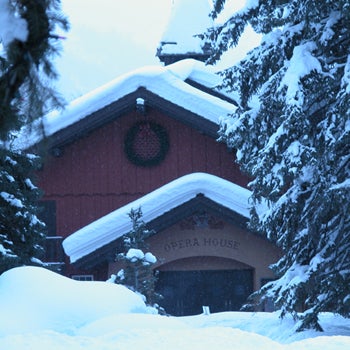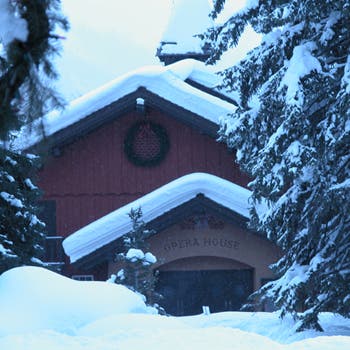Think Outside the Penalty Box


BEFORE HE BECAME THE OWNER of Points North Heli Adventures, ski guide and personal trainer Kevin Quinn spent seven years as a professional hockey player, and dished out so much on-ice justice he earned the nickname The Enforcer. The fans loved it, but Quinn-who grew up skiing and skating in Alaska-wanted out. “I couldn’t get the mountains out of my head,” he says.
A decade later, Quinn no longer breaks noses for a living. As the founder of the largest heli-ski operation in the U.S., he skis 150 to 200 days a year, and regularly drops 3,000-foot lines down 50-degree faces. His ability, he says, comes from years spent in the rink. “Much of hockey training requires balance, agility, and plyometric drills,” he says. “Those same skills keep you upright and confident in big mountain no-fall zones.” Check out the slideshow below to see his methods for training, including plyometrics, balance, and cardio skating.
PLYOMETRICS
“Plyometrics were the basis for much of my hockey training. All that running, leaping, and striding is the reason I’ve never had knee problems as a skier,” says Quinn. If you’re new to plyometric training, start this workout slowly: The explosive nature of plyos can strain weak muscles and tendons. And if you’re a woman, take note: “It’s commonly known that women are at a higher risk for ACL injuries than men,” says Kirby L. Turnage, clinical assistant professor of orthopedic surgery at Florida State University and team physician for the Pensacola Ice Pilots hockey team. “Training is the best preventative measure.”
A) Lateral Jump
THE MOVE: Begin by marking the floor with a piece of tape or setting up a bench. Stand on one side of the bench and bend into a slight squat. In one explosive movement, jump laterally over the bench, landing in a squat. Continue jumping side to side for a full minute. As you progress, add weights.
TAKE IT EASY: Whenever you incorporate high impact moves into you workout, start slow. Begin this exercise by stepping from side to side.
B) Single-Leg Depth Jump
THE MOVE: Stand on a 12- to 18-inch-high box or bench. Step off the box onto one foot. Immediately jump as high as you can. Land on the floor, on the same foot you started with. When this becomes easy, use a bigger box. Repeat for a full minute, and then alternate legs.
TAKE IT EASY: Start by stepping off a low box or stair with one foot and landing with both feet. Eventually progress to landing on one foot.
BALANCE
A strong core will keep you upright and centered on your skis, protect your ankles and knees, and help you avoid injury if you crash.
C) Hop the Clock
THE MOVE: Imagine you’re standing at the center of a clock. Balance on one foot and explode as far as you can from the clock’s center to each number and back (center to 12 o’clock and back, etc.). Make a full circle, and then repeat with the other foot.
TAKE IT EASY: Start by standing on a pillow or wobble board with both feet. Just stand there until you can balance confidently without falling off. When you master that, try standing on one foot; then progress to the clock hop on a flat surface.
D) On the Ball
THE MOVE: Holding an eight-pound medicine ball, kneel on a fitness ball and try to maintain your balance with a straight back and tight abs. When you can balance easily for several seconds, try standing on the ball, sans weight (have a friend spot you). Experts can jump from the floor to the ball–or stand on it, holding the weight.
TAKE IT EASY: With a friend holding your shoulders for added stability, kneel on the ball and try to maintain your balance. When you master that, try holding a medicine ball.
CARDIO SKATING
“The striding motion of inline skating replicates skiing on flats or traversing a glacier,” says Quinn. “You can do cardio sprints for more intensity and prepare your heart and lungs for big mountains.”
E) Inline Intervals
THE MOVE: On a relatively flat course, alternate one minute of hard skating in a tuck position with one minute of easy skating in an upright position. Continue for 30 minutes.
TAKE IT EASY: Practice skating upright on a flat course. If you’re new to inline skating, you may want to try Ice Wheels ($40 and up; icewheels.net), new wheels that more closely mimic ice skating and skiing. Instead of using a heel brake, use the flat-bottom wheels to snowplow or perform a sideways hockey stop.
EAT CLEAN
As a nationally certified trainer, Quinn insists that his athletes drink about four quarts of water a day. Same goes for his heli clients. “When you exercise without a good diet and water, it’s like taking one of those snow globes and shaking it. You stir up all this crap, but you never flush it out of your system,” he says.
Use all that water to wash down healthy portions of high-quality carbs and protein like whole grains and chicken. Avoid refined sugar and unhealthy fats. “In hockey, we spent the off-season doing cardio and bulking up by eating enough. Skiing is similar. It’s not about dieting, but portion control and eating clean.”
OCTOBER 2005